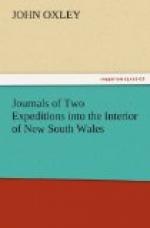October 13.—Crossing the point of land on which we had been encamped, we came to a sandy beach, on which we travelled three miles and a half. At the end of it was an opening safe for boats, (and probably for small craft at high water), into an extensive lake. As we had no canoe by which to cross over, we were obliged to keep along its north shore with an intention of going round it. The lake formed a large basin with a deep channel, which as it approached the base of the northern Brother narrowed into a river-like form, and in the course of a mile it again expanded from the north-north-west to the south-west, to a very great extent. The land on its eastern side was low and marshy (fresh water). To the north and north-west, it was bounded by low forest hills covered with luxuriant grass; and to the southward and south-west extended along apparently the same description of country, nearly to the western base of the Second Brother. The ranges of high, woody hills laid down by Captain Flinders dwindle when approached into low unconnected forest hills. The Northern Brother, the highest of the three, is a long hill of moderate elevation, and is seen from such a distance in consequence of the other parts of the country being comparatively low. The timber was chiefly black butted gum [Note: Species of eucalyptus], stringy bark, turpentine tree, and forest oak [Note: Casuarina torulosa]. The stones are chiefly a hard sandstone. On the lake were great numbers of black swans, ducks, etc. Various small inlets from the lake much impeded us, and after travelling near seven miles along its shores, we halted for the evening near a small spring of fresh water, in a good rising grass country. The easternmost highest part of the North Brother was S. 4. W. From the observed amplitude of the sun at rising this morning, the variation was found to be 9. 33. E.
October 14.—We were considerably delayed in our progress this day by salt water inlets, which occasioned us much trouble to cross, and at length we were altogether stopped by a very wide and deep one, near the west end of the lake: it was too late in the day to take any measures for crossing it this evening; we therefore pitched our tents on the banks near a swamp of fresh water which borders on it and the lake, from which we were distant about




